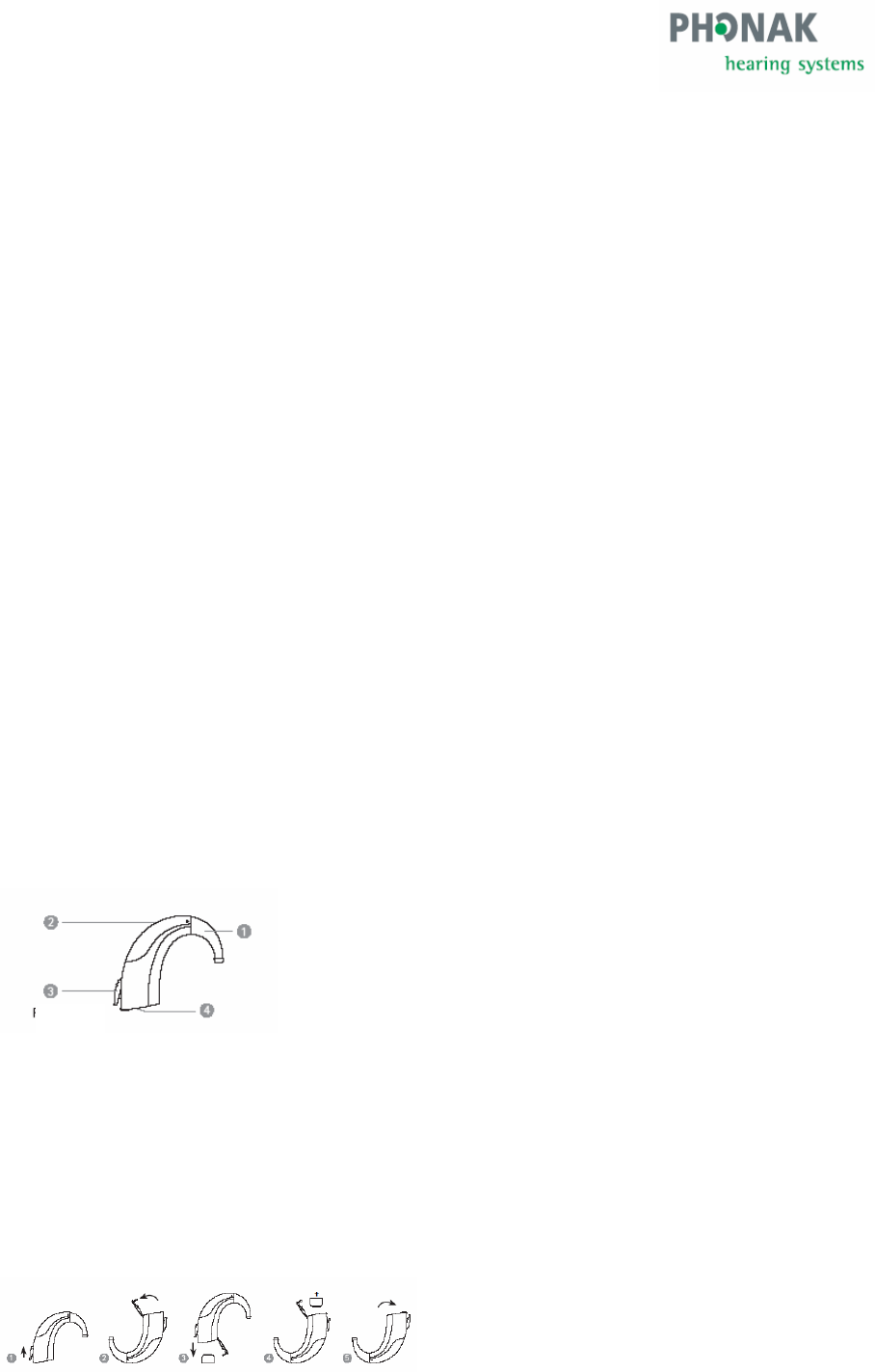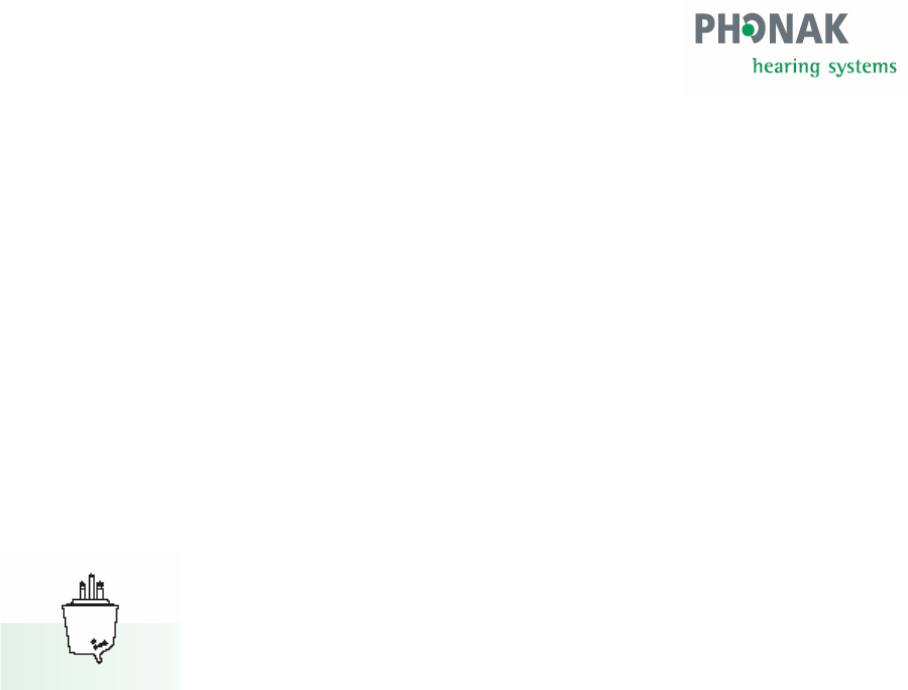Sonova USA CTX Low Power inductive Transmitter User Manual
Phonak Inc Low Power inductive Transmitter Users Manual
Users Manual

User guide [DRAFT]
Bi-CROS CTX / CRX
Welcome
This new wireless Bi-CROS solution is the gateway
to a completely new hearing experience. To obtain
maximum benefit from the Bi-CROS and its
comprehensive features, please read this user guide
carefully. Ask your hearingcare professional if you
have any questions.
Phonak wishes you much hearing enjoyment.
How to wear
The behind-the-ear instrument (CTX) is worn on the deaf ear.
The small receiver (CRX) with the 3 pins can be plugged into the
Hearing instrument worn on the other ear.
Instrument description
1. Ear hook
2. Volume control
3. ON/OFF switch
4. Battery compartment
How to change batteries
1. Switch off the instrument
2. Open the battery door

3. Remove the old battery
4. Remove the tab from the new battery (type 13) and insert it. Make
sure that the ‘+’ sign (flat side of the battery) is on the same
side as the battery door.
5. Gently shut the battery cover, until you feel it ‘click’ into place and
switch on the instrument.
CRX switch settings
• OFF: Right side
The signal from the behind-the-ear instrument (CTX)
on the deaf ear cannot be received.
• Speech signal from CTX only: Middle position (one dot)
The microphones from the hearing instrument are off.
• CTX and hearing instrument signal mixed: Left side (two dots)
It is recommended to use this setting for standard use.
Important points
• Do not use water or other fluids for cleaning.
• Use only original Phonak accessories.
• The CTX and CRX may only be repaired by an
authorized service center.
Warning
Changes or modifications made to this equipment
not expressly approved by Phonak may void the FCC
authorization to operate this equipment.
Declaration of conformity
Phonak AG,
Laubisrütistrasse 28, CH-8712 Stäfa, Switzerland
confirms that the CTX conforms to EN 301-489-9,
CFR47 part 15 subpart C and EN 300 330-1.
FCC ID: KWCCTX
Phonak AG
Stäfa, Switzerland
Date: June 22, 2004
Service and warranty
Phonak provides a manufacturer’s limited warranty for

your CTX. This covers all manufacturing and
material defects. Problems with CTX arising from
improper handling or care and repairs made by an
unauthorized party are not covered by the warranty.
Please ask at the point of sale for full details of this
warranty. The salesperson will note the serial number of
your CTX below. It will be needed in the event
of a warranty repair.
Serial number CTX: ………………………………………..
Date of purchase: ………………………………………..
Serial number CRX: ………………………………………..
Phonak distributors worldwide
Group companies: (detailed information on
www.phonak.com)
Australia Phonak Australasia Pty. Ltd.
Baulkham Hills N. S.W. 2153
Austria Hansaton Akustische Geräte GmbH
5020 Salzburg
Belgium Lapperre N.V., 1702 Groot-Bijgaarden
Canada Phonak Canada Limited,
Mississauga, Ontario L5S 1V9
Denmark Phonak Danmark A/S, Nitivej 10
2000 Frederiksberg
France Phonak France SA, 69500 Bron
Germany Phonak GmbH, 70736 Fellbach-Oeffingen
Italy Phonak Italia S.r.l., 20159 Milano
Japan Phonak Japan Co., Ltd., Tokyo 101-0044
Jordan Phonak Middle East, 11181 Amman
Netherlands Phonak B.V., 3439 ME Nieuwegein
New Zealand Phonak New Zealand Ltd.
Takapuna, Auckland 9
Norway Phonak AS, 0105 Oslo
Spain Phonak Iberica S.A., 03008 Alicante
Sweden Phonak AB, 117 34 Stockholm
Switzerland Phonak AG, Phonak Schweiz, 8712 Stäfa
United Kingdom Phonak UK Limited
Warrington, Cheshire WA1 1PP
USA Phonak Inc., Warrenville, IL 60555-3927
Independent A complete list of Phonak distributors
general agents: is available at Phonak's Internet site:
www.phonak.com. Please visit us or ask
your hearingcare professional for
information.
Manufacturer: Phonak AG, Laubisrütistrasse 28
CH-8712 Stäfa, Switzerland
This device complies with Part 15 of the FCC Rules
and with RSS-210 of Industry Canada.
This equipment has been tested and found to comply
with the limits for a Class B digital device, pursuant to
Part 15 of the FCC Rules. These limits are designed to
provide reasonable protection against harmful interference
in a residential installation. This equipment generates, uses
and can radiate radio frequency energy and, if not installed
and used in accordance with the instructions, may cause
harmful interference to radio communications. However,
there is no guarantee that interference will not occur in a
particular installation. If this equipment does cause harmful

interference to radio or television reception, which can be
determined by turning the equipment off and on, the user is
encouraged to try to correct the interference by one or more
of the following measures:
• Reorient or relocate the receiving antenna.
• Increase the separation between the equipment and receiver.
• Consult the dealer or an experienced radio/TV technician for help.
Operation is subject to the following two conditions:
(1) this device my not cause harmful interference, and
(2) this device must accept any interference received, including interference that may cause undesired
operation.